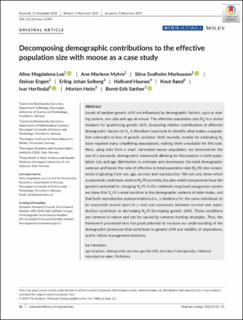| dc.contributor.author | Lee, Aline Magdalena | |
| dc.contributor.author | Myhre, Ane Marlene | |
| dc.contributor.author | Markussen, Stine Svalheim | |
| dc.contributor.author | Engen, Steinar | |
| dc.contributor.author | Solberg, Erling Johan | |
| dc.contributor.author | Haanes, Hallvard | |
| dc.contributor.author | Røed, Knut | |
| dc.contributor.author | Herfindal, Ivar | |
| dc.contributor.author | Heim, Morten | |
| dc.contributor.author | Sæther, Bernt-Erik | |
| dc.date.accessioned | 2020-07-09T07:59:52Z | |
| dc.date.available | 2020-07-09T07:59:52Z | |
| dc.date.created | 2020-01-09T12:43:48Z | |
| dc.date.issued | 2020 | |
| dc.identifier.citation | Molecular Ecology. 2020, 29 (1), 56-70. | en_US |
| dc.identifier.issn | 0962-1083 | |
| dc.identifier.uri | https://hdl.handle.net/11250/2661530 | |
| dc.description.abstract | Levels of random genetic drift are influenced by demographic factors, such as mating system, sex ratio and age structure. The effective population size (N e) is a useful measure for quantifying genetic drift. Evaluating relative contributions of different demographic factors to N e is therefore important to identify what makes a population vulnerable to loss of genetic variation. Until recently, models for estimating N e have required many simplifying assumptions, making them unsuitable for this task. Here, using data from a small, harvested moose population, we demonstrate the use of a stochastic demographic framework allowing for fluctuations in both population size and age distribution to estimate and decompose the total demographic variance and hence the ratio of effective to total population size (N e/N ) into components originating from sex, age, survival and reproduction. We not only show which components contribute most to N e/N currently, but also which components have the greatest potential for changing N e/N . In this relatively long‐lived polygynous system we show that N e/N is most sensitive to the demographic variance of older males, and that both reproductive autocorrelations (i.e., a tendency for the same individuals to be successful several years in a row) and covariance between survival and reproduction contribute to decreasing N e/N (increasing genetic drift). These conditions are common in nature and can be caused by common hunting strategies. Thus, the framework presented here has great potential to increase our understanding of the demographic processes that contribute to genetic drift and viability of populations, and to inform management decisions. | en_US |
| dc.language.iso | eng | en_US |
| dc.rights | Attribution-NonCommercial-NoDerivatives 4.0 Internasjonal | * |
| dc.rights.uri | http://creativecommons.org/licenses/by-nc-nd/4.0/deed.no | * |
| dc.title | Decomposing demographic contributions to the effective population size with moose as a case study | en_US |
| dc.type | Peer reviewed | en_US |
| dc.type | Journal article | en_US |
| dc.description.version | publishedVersion | en_US |
| dc.source.pagenumber | 56-70 | en_US |
| dc.source.volume | 29 | en_US |
| dc.source.journal | Molecular Ecology | en_US |
| dc.source.issue | 1 | en_US |
| dc.identifier.doi | 10.1111/mec.15309 | |
| dc.identifier.cristin | 1769323 | |
| dc.relation.project | Norges forskningsråd: 244647 | en_US |
| dc.relation.project | Norges forskningsråd: 223257 | en_US |
| dc.relation.project | EC/FP7/268562 | en_US |
| cristin.ispublished | true | |
| cristin.fulltext | original | |
| cristin.qualitycode | 2 | |

